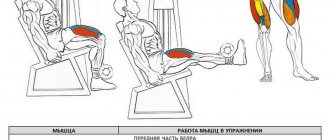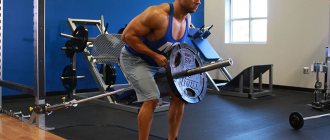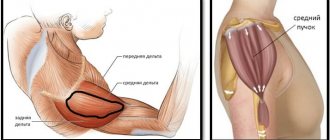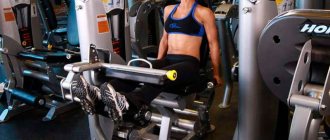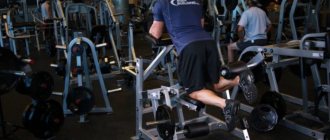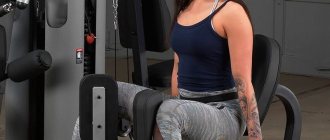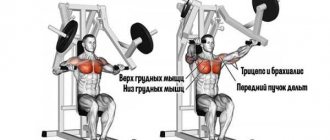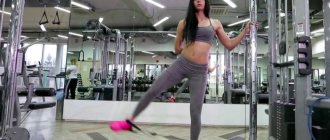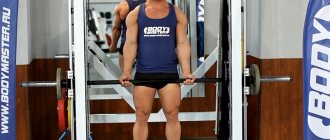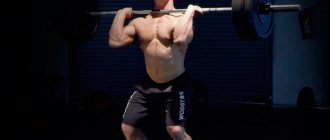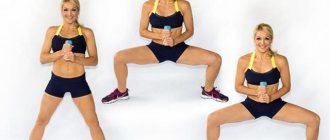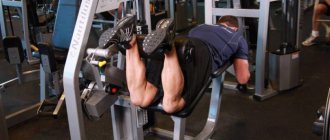The downward press exercise in a block simulator (block) pumps the lateral as well as the long head of the triceps, highlighting the lateral part of it. Formative exercise.
The cable press puts emphasis on the lateral head of the triceps, giving the entire muscle a distinct horseshoe shape that is advantageously visible from the side of the arm.
The more developed the lateral head of the triceps is, the wider the top of the arm appears when you look at it from the front. The downward press is also very effective at cutting the dividing line between the triceps and biceps.
Be sure to include the press down in your strength training program if you are involved in shot put, basketball, gymnastics, boxing, hockey, swimming, tennis, badminton.
Bent press in a block machine - triceps exercise
Principles
Each of the following exercises is recommended to be performed after the main workout in 3-4 sets of 12-15 times.
The optimal solution would be to take a light weight, since the emphasis is on the quality of the repetitions: the arms are bent only through the biceps, other muscles should not be involved. To avoid injury, the muscles need to be well warmed up before exercise.
There are several types of biceps curls:
- curls on the Scott bench;
- crossover curls;
- biceps pulldown.
Scott Bench Curls
The exercise is aimed at maximum isolation of the biceps: during execution, only one joint works - the elbow, and isolation of the muscle is achieved not due to the absence of a barbell, but by fixing the arms in the machine.
Execution technique
- Sit in the machine, straighten your back, place your feet on the stand, position your elbows and shoulders so that it is comfortable for you to perform the exercise.
- Take the handles of the machine with an open grip and bend your elbows, feel the tension in your biceps.
- Slowly raise your forearm up as you exhale, bending your elbow joint, while trying to pull your arms up, and not towards you, to increase the amplitude.
- Stop the flexion at the peak (bending your elbow approximately 90 degrees), and hold your arms at the peak for 1 second.
- From the peak point, lower your arms 2 times slower, but do not extend them completely; the biceps should be tense until the end of the approach.
Arm curls with overhead pulley handles
The exercise isolates the biceps in the same way, with a small auxiliary load placed on the shoulders. It is performed on a “crossover” simulator with block frames on the sides.
Execution technique
- Attach the handles to both cables on the machine, then grab them one at a time.
- Stand parallel to the racks of the machine: feet shoulder-width apart, arms slightly bent at the elbows.
- Taking a deep breath, bend your elbows; When performing, firmly hold the handles - a strong grip will allow you to do more repetitions.
- When your hands almost touch your shoulder muscles, pause for 1-2 seconds - in this position the biceps are maximally tense.
- As you exhale, return your arms to their original position. Remember that during the exercise the body is motionless, only the biceps are working.
Biceps lat pulldown
Also performed in a crossover, but in this case one block frame is used. Like all the previous ones, this exercise isolates the load on the biceps (on its middle and lower parts).
Execution technique
- Take the bar with a reverse grip (palms facing up), stand straight, do not spread your elbows to the sides.
- As you inhale, begin to flex your biceps, making sure that your elbows and shoulders are motionless. Raise the bar until you reach the peak of the range of motion.
- At the peak, squeeze your biceps additionally, hold your hands in this position for about 2 seconds, then, as you exhale, lower your hands 2 times slower to the starting position.
Contraindications
Unfortunately, bicep exercises and going to the gym in general require a certain level of health, which not everyone has.
Some problems will not be critical if you are careful during training and perform the exercises carefully:
- Lack of physical activity. In this case, it is understood that the person does not lead an active lifestyle, and he is strictly prohibited from starting with heavy loads.
- Thyroid diseases. The patient experiences a hormonal imbalance, muscle growth slows down, etc. Light loads are also recommended.
- Scoliosis and osteochondrosis. Scoliosis is curvature, deformation of the physiological curves of the spine, osteochondrosis is dehydration of the intervertebral discs, a decrease in their elasticity and height, which leads to back pain. The diseases are interrelated: as a result of the first, the second appears.
Heavy physical activity will only contribute to the development of the disease, so you need to exercise to a minimum, if possible excluding exercises that involve the spine.
There are also diseases for which any exercise is completely prohibited:
- Pressure changes.
- Bronchial asthma.
- Various chronic heart diseases.
Women, in turn, should not visit the gym during the late stages of pregnancy and during menstruation.
Before starting an active sports life, you should definitely consult your doctor.
The key to success lies in setting the right goal. Do basic exercises, finish the workout with isolating exercises, and don’t forget to alternate exercises so that your muscles don’t have time to get used to the load. With due persistence and a certain amount of load control, the results will be noticeable within a couple of months.
What muscles does the face pull work?
Bent-over dumbbell row with one arm
Face row is aimed at developing the muscles of the shoulder girdle. These include:
Rear delta Most athletes do not pay enough attention to the development of these muscles. Therefore, their shoulders do not have a pronounced rounded shape. Pull to the face will solve this problem. The function of the rear deltoid is to move the arm back (shoulder extension) and rotate it outward (towards the thumb).
Rotator cuff. Responsible for shoulder stabilization and rotation. It consists of 4 small muscles: supraspinatus, infraspinatus, subscapularis and teres minor
It is very important to understand what role each of them plays in this exercise. The infraspinatus and teres minor are responsible for abducting the shoulder back and rotating it outward
At this moment, the supraspinatus muscle pulls the humerus toward itself, preventing impingement syndrome. The subscapularis is activated when the arms return to their original position, rotating the humerus medially (towards the little finger).
In addition to the shoulder girdle, the back muscles are involved in the movement. These include:
- Diamond-shaped.
Responsible for bringing the shoulder blades towards each other. - Trapezoid.
In this exercise, most of the load falls on its middle sections. Together with the rhomboids, it brings the shoulder blades together and is responsible for their stabilization.
The abdominal muscles also act as stabilizers of the torso.
and lats.
Execution technique
Initial position
- The movement starts from the point that many consider the middle of the amplitude. You need to start extending your arms from the “forearm parallel to the floor” position;
- You can take the correct position by standing at a distance of 30-40 cm from the crossover block;
- The handle should be grasped evenly, at the same distance from the center, with both hands;
- Bend slightly forward and slightly bend your knees;
- Take a breath, fix your abs;
- Reduce the shoulder blades to the spine and lower them to the pelvis;
- Keep your shoulders turned and in the same position
Movement
- As you exhale, you need to straighten your arms only at the elbow joints, leaving your shoulders stable;
- At the bottom point of the movement, you should linger, contracting your triceps;
- Then - return to the center of the amplitude and do not bend your elbows additionally in order to “push” the weight towards your shoulders;
- After completing the required number of repetitions, you need to return the projectile to its original position.
One-arm standing kettlebell press
Attention
- The exercise is isolated - there is no need to “work” with your legs, body and abs;
- The more emphasis is placed on bending forward, the less stress the triceps receive;
- You cannot throw the weight in a negative phase; you need to smoothly lower it, as if “bringing it” with your muscles;
- You should control your elbows so that your forearms do not move too far from your body;
- The pace should be smooth and the same, there is no need to push the block down due to inertia and work in jerks
Recommendations
- The arms need to be extended exactly to the point where the tension is felt, but not overextended, “locking” the elbow;
- Do not bend your wrists so as not to overload the ligaments;
- It is better to keep brushes stiff;
- Block – keep suspended until the end of the exercise
This is a STANDING ARM EXTENSION, baby.
Watch this video on YouTube
Mistakes in training the pectoral muscles
The two biggest mistakes most people make in their training are:
- Focusing on the wrong exercises. Many people pay excessive attention to machines and isolation exercises, which have a secondary role in creating impressive muscle mass in the chest muscles.
- Lots of repetitions. Repeated training will only tone the muscles, but not build them.
The more you perform compound movements with heavier weights (80-85% of your maximum and above), the better your results will be.
Vertical block row: how many times to do?
One-arm kettlebell push with lunge
Beginners (and especially girls) are recommended to perform overhead rows of 12-15 repetitions and with a weight not exceeding half of their body weight. Increase the working weight only after you can clearly feel that it is the latissimus dorsi muscles that are doing the work in the exercise, and not the arms or other core muscles.
Remember that in order to pump up your back muscles, you first need to learn to feel them - otherwise you simply will not be able to consciously include them in your work
And in order to learn to feel your back, it is important to perform lat pulldowns with perfect technique, slowly and with adequate working weight - and not just chase records for speed or number of repetitions
***
The seated lat pull-down, a variation of pull-ups on a bar, is one of the basic exercises for developing back muscles. Common mistakes when performing this exercise include pulling at the head rather than the chest, using too much weight, and performing the movement at an excessively fast pace that does not allow the muscles to consciously engage the muscles in the work.
Typical beginner mistakes
Let's look at the typical mistakes of novice bodybuilders when doing chest presses in block weight machines. Most of the “jambs” have already been voiced, so let’s summarize :
- elbows pushed too far back;
- improper breathing;
- pauses between repetitions;
- sudden jerks;
- pushing out the weight with the body (this should be done with the pectoral muscles);
- incorrect height adjustment of handles;
- legs brought together or straightened at the knees.
Interesting Facts
Here are a number of outstanding records in the history of the bench press.
- The world record for bench press in multi-equipment belongs to the American Ryan Kennealy and is 485.4 kg in the 155+ weight category.
- The Russian record holder for bench press in multi-equipment is Tsukanov Maxim, he was able to bench press 267.5 kg in the heavy weight category 140+.
- Without equipment, the maximum pressed weight is 319.8 kg, and this record belongs to James Henderson. Weight category is also 155+.
- If we talk about girls, the current world record for bench press in multi-equipment is 188.2 kg. It was established in 2016 by Lexi Harris in the heavy weight category of 100+ kg.
- Without equipment, Abigail Wade was able to squeeze the most; her record is 150 kg in the 100+ weight category.
The video presents the standards and execution schemes, and will also tell you how much athletes work out to achieve a rank.
Cable Handle Cable Press
Initial position:
- Face the block.
- Firmly grasp the handle. The knuckles of both hands touch.
- Elbows are bent and pressed to the sides.
Performance:
- Slowly straighten your elbows, lowering the ends of the handle down and to the sides.
- At the lowest point of the amplitude, turn your hands with your little fingers up. Stay in this position for a second or two.
- Rotate your hands back and slowly return to the starting position.
Recommendations:
- With a cable handle, the downward press is more difficult to perform. You will have to reduce your normal working weight by at least a third.
- It is better to do the exercise with gloves, otherwise your palms will slide on the smooth surface of the rope.
STRAIGHT ARM PRESSES
Benefits and Benefits of Exercise
So, let's look at a number of advantages that the barbell press brings:
- This is one of the best exercises for gaining mass and increasing the muscles of the upper body.
- It strengthens the joints of the shoulder and elbow.
- There are a variety of options - from simple for beginners to complex for advanced levels.
- You will be able to regulate not only the level of load, but also concentrate it on certain muscle groups, changing the technique.
- Compared to the dumbbell press, which also has its advantages over the barbell, in this case you will be able to lift heavier weights more easily.
- In addition, the load will be distributed in such a way that there is less chance of losing control of movement than with dumbbells.
Shoulder press on a block machine
You can work the deltoid muscles in a Hammer in a sitting position, doing a vertical press up. Simulates working with dumbbells or a barbell. The equipment resists evenly. The angle of inclination in the simulator should be selected to concentrate the maximum load on the deltoid muscles. The athlete can work with each hand separately. You need to perform the exercises efficiently:
- The back should not come off the bench.
- All movements must be isolated.
- In this device, the joints do not experience excessive load.
Upper block pull
You need to enable JavaScript to vote
Top pull on blocks
The seated lat row (or lat row) is a key exercise for comprehensive upper body development. The key muscle groups worked in this exercise are the latissimus dorsi, shoulder girdle muscles, as well as the biceps and forearms.
In essence, lat pull-downs are analogous to pull-ups on a bar. however, performing the exercise on a machine allows athletes to focus on proper technique or, with proper muscle development, use additional weight above their own body weight.
Back training for mass - the main rules for muscle growth and a description of the six best exercises.
Anatomy exercises
The main muscle group worked when performing seated lat pull-downs is the latissimus dorsi. however, depending on the type of handle and the width of its grip, it significantly changes which secondary muscles take on the additional load.
When performing an overhead row, the palms can be directed either towards or away from you - in the first case, the involvement of the biceps significantly increases. When using a parallel handle (palms facing each other), the pectoral muscles are more actively involved in the work.
Upper pull: to the chest or behind the head?
Despite the fact that many beginners feel that when performing overhead pull-downs behind the head rather than to the chest, the involvement of the back muscles in the work increases, this version of the overhead pull-down significantly increases the risk of injury to the shoulder joints (especially when working with heavy weights).
With an overhead pull, most of the load is transferred from the back muscles to the shoulders and spine, causing overstrain of the joints at the bottom point of the trajectory. It is recommended to either not use the overhead row at all, or to perform this variation of the exercise with a low weight.
Upper block pull: description of technique
Starting position. sitting on a machine bench, hips are fixed. Grab the bar with all your fingers (thumb also on top), the grip width is such that your elbows are parallel to each other. Feel the conscious tension in your core and abdominal muscles.
Then lower your shoulders down, bringing your shoulder blades together, as if “opening” your back and pushing your chest forward. Your feet are firmly on the floor, your neck is in line with your spine, your gaze is directed forward (never look up). There is a slight arch in the lumbar region.
Correct exercise mechanics
Execution mechanics. As you exhale, begin to slowly pull the bar down towards your chest, opening your chest even more. Make sure that your shoulder blades are constantly brought together and maintain a stationary position of your back, without leaning back or increasing the arch in your lower back.
Pause for a few seconds at the bottom point of the trajectory (the bar is located 3-5 cm from the chest, but does not touch it), feeling the tension in the latissimus dorsi muscles. Elbows point slightly back. Then slowly and with complete control, return the weight to the starting position.
Developing back muscles is the main problem for beginners. All about how to start engaging your back in basic exercises.
Top pull: the most common mistakes
A common mistake when performing seated lat pull-downs is using too much weight. This makes it impossible to control technique (and especially keeping the shoulder blades together) and shifts the load from the back muscles to the arms and other secondary muscle groups.
Remember that the body must be strictly fixed when performing the exercise - you should not lean back or arch your whole body to lower the weight. If you can't keep your core still, you're definitely using too much weight.
How to learn to feel your back?
To pump up your back muscles, you first need to learn to feel them - otherwise you simply will not be able to consciously turn them into work
In order to learn to feel your back, it is important to perform lat pulldowns with perfect technique, slowly and with adequate working weight
Beginners are recommended to perform this exercise for 12-15 repetitions with a weight not exceeding half of their body weight. Increase the weight only after you can feel that it is the latissimus dorsi muscles that are doing the work, and not the arms or other core muscles.
The seated lat pull-down, a variation of pull-ups on a bar, is one of the basic exercises for developing back muscles. Typical mistakes when performing this exercise are pulling behind the head rather than to the chest, as well as using an excessively heavy working weight.
Advantages and disadvantages of the chest press
Advantages
- Isolated work of the pectorals with less involvement of the stabilizer muscles.
- The ability to work on each side separately. This will lead to a reduction in developmental imbalances.
- It is safe to perform bench presses on the machine. Even if you can't press the weight for one more rep, it still won't crush you. How this can happen when working with a barbell. Therefore, it becomes possible to work to failure without the help of a belayer.
- The load on the shoulder muscles, especially on the anterior bundles, is much less. Than when working with free weights (barbell, dumbbells).
- Makes it possible to finish off the pectoral muscles at the end of the workout (pumping). That is, the muscles are filled with blood and oxygen. Which contributes to better recovery after strength training.
- You can work with quite a lot of weight. Of course, the main thing is not to overdo it.
- Performing bench presses in the simulator occurs at a very large amplitude. Therefore, we can properly stretch the muscles at the lowest point.
- Ability to work with heavy weights in the eccentric phase (lowering the weight). This will trigger new stress and hormone production. Giving impetus to muscle growth.
As you can see, bench press in the simulator will help you get out of stagnation. This is especially true for professional athletes.
Flaws
- The bench press cannot replace basic exercises in terms of effectiveness.
- For some athletes, the vector set by the simulator may not be anatomically convenient. Consequently, they will not be able to develop the full potential of the pectoral muscles. Fortunately, such cases do not occur so often.
Basic exercises will always be most effective if our goal is to build muscle mass. But if we are talking about detailing the muscles and giving them shape. This is where isolated exercises come into play. Which includes the bench press in the simulator. Therefore, this drawback will be relevant only if we want to increase mass with the help of this exercise.
Pulldowns for girls Edit
Chest cravings
belongs to the category of basic exercises, since it moves the shoulder and elbow joints. As a result, not only all the back muscles work, but also the rear deltoids, biceps, long heads of the triceps and forearms.
Sit on a cable machine bench set in the upper position and grab the handle with an underhand grip. Hands approximately shoulder width apart (medium grip). You can also use an overhand grip. In this case, use a wide hand position (wide grip). Experiment with hand positions until you find one that suits you best.
Performing the exercise with a straight grip with a narrow hand position (narrow grip) is easier than with a wide reverse grip, however, in this version, the biceps work more and the back muscles work less. If you are a beginner, start with a straight, narrow grip.
You can also use a neutral grip, which allows you to put more force into the exercise than a straight grip. In the lower position, the back muscles are stretched more, and in the upper position the range of motion is limited.
Pull the handle at least towards your forehead. If you feel comfortable, pull it up to your upper chest. Hold this position for 1-2 seconds, then slowly return the handle to its original position. Without straightening your arms completely, repeat the exercise.
The handle can be pulled to the chest or placed behind the head. The last option is the most difficult and traumatic for the shoulder joints, so we do not recommend it.
When performing rows and pull-ups, never extend your arms FULLY. When you straighten your arms, the muscles become severely stretched, which can lead to tears in your biceps and shoulder muscles. You should maintain constant muscle tension without fully extending your arms. Some women straighten their arms to rest between reps. If you choose this option, keep in mind that hanging from a bar puts your shoulder ligaments in a vulnerable position. Try to perform rows and pull-ups in one smooth motion, without jerking.
Option: pull-up Edit
As you get stronger, you can move from machine rows to pull-ups. So, grab the bar with a reverse medium grip. Bend your knees at an angle of 90 degrees, leaving your hips motionless. Cross your legs so that your right foot is on top of your left ankle. Make sure you have a firm grip on the bar (press your index finger or even your middle finger with your thumb).
Using your back muscles, pull yourself up to a position in which your forehead is at the level of the bar. If you can, pull yourself up a little higher and rest your chin on the bar. To do this, tilt your head back a little. Hold this position for a second, then slowly lower down. Do not straighten your arms completely. Maintain constant muscle tension to avoid injury.
It's common for you to sway as you do a pull-up. To avoid this and keep your body straight, tighten your buttocks and press your right foot onto your left ankle. This will help you avoid swaying.
To increase the intensity when you can easily perform 12-15 bodyweight pull-ups, you can hold a dumbbell between your legs.
It does not require much time and works a large number of body muscles at the same time.
Allows you to change the load you want to apply to the muscles. After each subsequent approach, you can change the load a little. When doing pull-ups, it is much more difficult to do it.
Unfortunately, many women cannot do pull-ups on a horizontal bar, which is very frustrating for them. To solve this problem, you can use pull-up machines, which allow you to choose a load that matches your strength level. This will allow you to complete the set number of repetitions.
Exercises for pumping chest muscles
All chest muscles can be roughly divided into three parts - upper, middle and lower. Each part is better stimulated depending on the change in angle at which you perform the exercise.
- For the upper part, exercises performed on a bench at an upward angle of 30-45% are best suited.
- For the middle part, exercises performed on a flat bench are best.
- For the lower part, exercises performed on a bench at a downward angle of 30-45% are best suited.
All chest exercises must be performed with perfect form because poor form can become a habit that will lead to lack of progress or worse, injury in the future. The following are exercises you can do to train your chest muscles, and a step-by-step guide will help you achieve perfect technique.
Bench press: types and methods of execution
The traditional barbell bench press is a required exercise in most strength training programs, but there are also several variations that allow you to develop different muscle groups. Let's look at the most popular:
Dumbbell bench press.
To be honest, this exercise cannot be called a full replacement for the bench press with a barbell, but it still deserves attention. The hardest part of this exercise is keeping the dumbbells in the correct position. But it develops coordination and the ability to keep the load balanced, which helps when working with a barbell.
Bench press on an incline bench.
There is often controversy in the bodybuilding community about the “upper chest.” Should we focus on developing this so-called upper part, or is it better to train the entire thoracic region at once? What exactly is included in this “upper” part?
The upper chest usually refers to the muscles located in the collarbone area, and although they are part of the pectoralis major muscle, their structure is quite different. So different exercises have different effects on the upper chest and the chest as a whole. Of course, you cannot train exclusively the clavicular muscles, because, as already mentioned, they are part of the pectoral muscle, but you can choose exercises that will have the greatest impact on strengthening the upper chest. The incline bench press is the best.
Try different bench inclinations ranging from 30 to 45 degrees to find the one that works best for you.
One more point - during the exercise, the bar should pass near the chin and touch the body not in the nipple area, but just below the collarbone. Thus, the vertical trajectory of the rod will be achieved.
Bench press with a narrow grip.
If you decide to strengthen your triceps, then the close grip press is the best exercise you won’t find. And trained triceps will allow you to show better results in the traditional bench press. The main thing is not to overdo it with a narrow grip - if you spread your hands just a few centimeters from each other, you will achieve unpleasant consequences in the area of the shoulders and wrists. So just keep your arms a little narrower than in a standard bench press, all other recommendations are the same (feet to the floor, shoulder blades to the bench, bar arcing and touching chest).
If you feel discomfort in your wrists, just spread your arms wider. Keep them apart until the discomfort disappears.
Reverse grip press.
Grasp the bar tightly with your palms facing you - this reduces the load on your shoulders and increases the effectiveness of working the upper chest. In general, this is all you need to know about the reverse grip; all other recommendations for performing the exercise are the same as the traditional grip.
Bench press on an incline bench upside down.
This type of bench press is practiced to develop the lower part of the pectoralis major muscle, but to train this part of the chest it is better to give preference to dips.
Calculation of optimal weight
The surest way to determine your optimal weight for training is practice. Just perform the exercise with different weights and you will find out which one is right for you with your current physical fitness. But if you are used to believing formulas and tables, then you can use Brzycki’s formula (there are also Bachley and dos Remedios formulas):
1 one-time maximum = M * (36 / (37 - k)) (where M is the weight of the bar, k is the number of repetitions with this weight)
You can use the following tables to estimate what people with different levels of training are capable of:
The "no training" column shows average bench press results for those who have not performed it before, the "average" column for those who have been training in the gym for several years, and the "professional" column for competitive athletes (1% of athletes).
Instead of a conclusion: how to increase your bench press performance?
1. Always grip the bar tightly.
2. When you remove the barbell from the racks, immediately begin performing the exercise, do not pause. Move the bar in a straight line.
3. Don’t get carried away with training your pectoral muscles – two sessions a week should be enough
Training affects the entire body and central nervous system, and not just a specific muscle group; it is important to give the body a rest. Avoid Overtraining
4. Constantly improve your movement technique. If you feel that towards the end of the exercise you are no longer thinking about technique at all, it’s time to unload the bar. Do not chase the maximum weight, prepare your body gradually.
5. Visualize. Imagine how you press a certain weight, scroll through the workout in your head. In this way, you will prepare yourself and your brain for increased load.
Inclusion in the training plan
To properly incorporate a new exercise into your training plan, follow these guidelines:
- warm up your arms and shoulder girdle before starting your workout;
- for a more thorough warm-up of the triceps, push-ups or close-grip presses are suitable;
- select the weight of the projectile based on your capabilities and general condition of the body;
- increase the weight gradually so that the technique of performing the exercise does not suffer;
- to start, include the French press in one workout per week;
- change execution techniques to evenly load all types of muscles.
The French press of a dumbbell, barbell or other apparatus is the optimal exercise for the qualitative development of the triceps, which determines the basic shape of a person’s arms. Following the correct technique and a competent training plan will allow you to achieve the desired result in a short time.
French bench press: technique and tips.
Execution technique and number of approaches
Exercises on the block seem elementary in terms of execution, but the downward pressing technique has its own nuances.
Correct execution of the exercise includes several important rules:
Starting position: stand in front of the block, take half a step back from the machine. Grasp the soft (rope) handle with your hands on top, palms inward, that is, with a neutral grip. You can put your feet side by side, or you can step back with one foot
It is important to feel that your position is stable. Bend down from your waist about 10-15 degrees, but no more. Point your elbows forward, extending them slightly. The pulley cable should be taut, and your hands should be at waist level. After taking in air, hold your breath. Inhaling, straighten your arms, lowering them down. Make sure your elbows remain in the starting position, bending and straightening
You also need to maintain the starting position from the beginning of the exercise until the end. While your arms are lowering, slowly open your hands along with the rope handle. When your hands are at the bottom, your palms should be facing towards your hips. Once you reach the bottom position, hold it for a few seconds while exhaling. Holding your breath, raise your arms up. Hold in the top position, inhale and begin the next movement.
As you perform your sets, make sure your muscles remain tense.
Start pressing after you have thoroughly worked on the triceps area. For example, start pressing on the block after working with a barbell or bending your arms behind your head with weights. The bench press will give additional load, which will have a good effect on the shape of the triceps.
You should perform the downward block press for 10-15 repetitions in 3-4 approaches. This regimen is also suitable for women and beginners, but they need to take less weight.
Important recommendations from trainers:
- Hold the handle firmly without relaxing your wrists.
- Turn your hands only by turning your forearm, not your wrists or elbows. Twisting will increase tension in the triceps.
- If you push your elbows out a little more, the tension in the long head of the triceps will increase.
- Do not lean forward more than 10-15 degrees, otherwise you will reduce the load on the triceps.
- Bodybuilders who exercise regularly use heavy weights for this exercise, but overloading will ruin the quality of the exercise.
The video shows how to correctly perform a bench press on a block machine. It describes how the choice of handle affects the result and the main mistake when performing:
Who is it useful for?
This simple bench press, which requires a regular exercise machine, is suitable for anyone who wants to create muscle volume in their arms.
It may seem that women or beginner athletes do not need the press down as much, but this is a mistake. Developed triceps are very noticeable and immediately form a beautiful shoulder silhouette. Don't forget - a developed triceps will not allow fat to accumulate on the back of the shoulder - one of the problem points of the female figure.
Those who have just started working out should pump up their triceps, at least so that the muscles in their arms develop evenly. Strong arms make it possible to gradually increase the load and achieve new results.
Experienced bodybuilders regularly perform this press to form a horseshoe shape of the muscles that make up the triceps and separate them in such a way that a pronounced relief is drawn.
The downward press, performed with a block, is also necessary for professional athletes who have chosen sports such as boxing or tennis, basketball or badminton, and swimming. That is, requiring great hand strength.
Analysis of the exercise
Working muscles
The main mover is the triceps, the triceps brachii muscle. The good thing about a pulley exercise is that it uses all three heads.
Additional muscles and stabilizers – muscles of the core, forearms, deltoids, latissimus, pectoralis, hips as stabilizers
pros
- It is considered “aesthetic”, developing only appearance, but this is not so. In strength sports it is used as a kind of “cool-down” after a heavy bench or standing press. Allows you to recover faster, which means it affects strength indicators, albeit indirectly;
- Can be performed in a gentle way - without putting a lot of stress on the elbows, does not stretch the ligaments, like many other triceps exercises, and is suitable for rehabilitation after injuries if performed with light weight;
- If you attach a rubber band to the block, it will be an excellent warm-up exercise before a heavy bench press due to variable changes in the load;
- At the end of the workout, you can, again, work with rubber or light weights to “drive” blood into the muscles and ensure recovery
Minuses
Not designed for strength work, is unlikely to build powerful triceps if the athlete does not press and does not work in a strength mode in other exercises
Tips for maximum efficiency
- The facelift can be performed at the beginning of any workout as a WARM-UP for the shoulder girdle muscles.
- This deadlift can also be included in your shoulder workout day training program. It is perfect for developing the rear delts.
- You can do this exercise at home. To do this, you need to purchase a rubber expander with a special bracket. I wrote about them in the article “EXERCISES WITH AN RESPANDER”.
- Don't chase weight. Still, the facelift is not a strength exercise. Focus on the quality of each repetition.
- If you feel like most of the stress is on your lower back, try doing facelifts from a seated position.
As you can see, this exercise is very effective when it comes to developing the rear deltoids and rotator cuff muscles.
To get a consistent result from it, you need to focus on the execution technique, and not the number of hanging blocks. If you have the opportunity to add face pulling to your program at least once a week, do it.
Only you can take care of the health of your shoulders.
Good luck to everyone in your training!
Are there any alternatives?
It is important to understand that we are talking about the “finishing” type of strength exercises. The seated press is performed at the end of the workout to focus attention on poorly developed muscle groups. The bench press is more popular, but it is not suitable for bodybuilders who have suffered a back injury. Thus, the bench press and seated press are interchangeable, but it all depends on the presence/absence of injuries. You can also achieve a similar effect by pressing dumbbells.
This is not a basic exercise. The seated press is an imitation. You lift the usual pancakes, only they are secured in blocks. This exercise will not seriously increase muscle mass, but you will get the desired relief.
Technique
How to do a standing French press? First, prepare the simulator. The most convenient way to perform an exercise on a block is a rope handle.
Take a comfortable position, moving two steps away from the machine.
- Firmly grasp the handle with both hands. Bend your elbows, lift them up, and place your palms behind your back. Elbows should be stable, do not spread them too far to the sides. Make sure your forearms are parallel to the floor. Look straight ahead. This is the starting position.
- Exhale and straighten your arms above your head. Do this slowly, without jerking.
- As you inhale, return to the starting position. The elbows must be locked throughout the entire movement.
- Do the intended number of repetitions, rest for a minute and repeat the exercise.
If you currently find it difficult to do the French press on the lower block, you can simplify it. Place a bench parallel to the machine and sit on it. In this position, the load will be somewhat redistributed, which will allow you to perform a high-quality bench press and work your muscles. After about a month, you can switch to the standard version of the exercise and do it standing.
Muscle load
First of all, the standing French press engages the triceps, especially its long head. If you do the exercise regularly, soon the triceps will stand out noticeably from the rest of your arm. In addition, the definition of the separation of the biceps and triceps will increase, which will make your arms more prominent and your body more impressive. The exercise also works a number of accessory muscles, particularly the elbow muscle. It is actively involved in the movement, since it is also responsible for extending the arm at the elbow.
French press - performed on the lower block.
To make the movement as effective as possible, perform a moderate number of repetitions over a large number of sets. Beginners are recommended to do 3-4 sets of 7-12 repetitions.
It is best to train the triceps on the lower block in the middle of the session. Alternatively, before it you can do a barbell press while standing or sitting, and after it you can do a bent over arm extension.
The exercise is allowed for all athletes, from beginners to professionals. The only contraindication is recent spinal injuries.
Before you start training
Despite the fact that the exercise is relatively simple, pay attention to a number of contraindications to its implementation
- If your elbows hurt, it is not recommended to do the exercise until the acute pain syndrome passes. It is advisable to do an MRI of the elbow joint to clarify the etiology (origin) of pain.
- If your wrists hurt, you should also let them recover. You can try using a medium-hard hand brace. If you do extensions with them painlessly, train calmly.
- After fractures, you need to wait a few weeks after removing the cast and start doing extensions with small weights. This will help restore ligaments and tendons that have become unaccustomed to stress and prepare the joint for further weights.
When is it contraindicated?
The downward press performed on a block machine is not a mandatory exercise at all. If there are contraindications, then you can refuse it.
But there are almost no contraindications. It is important to have healthy arm muscles, elbow joints and a healthy heart.
- Before the exercise, it is important to check whether the machine is broken and whether the parts are securely fastened.
- Do not place loads that are too large for yourself - this may cause injury.
- Take breaks between sets and restore your breathing.
The downward press on a block machine is a good addition to the main training process. Thanks to the bench press, an athlete can achieve good results - create shoulder relief with highlighted muscles, and also achieve triceps strength.
